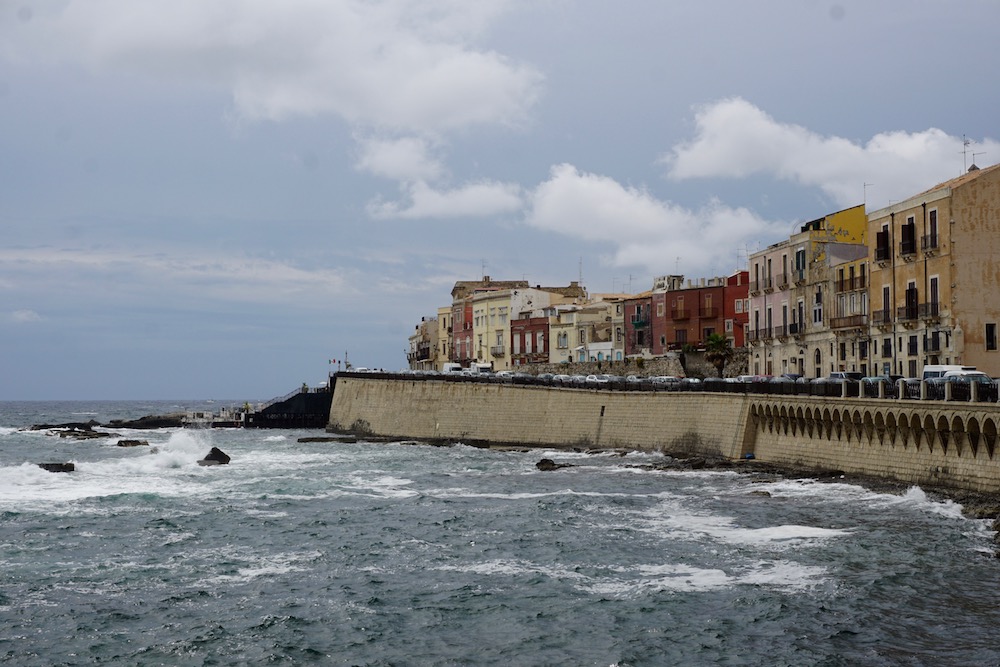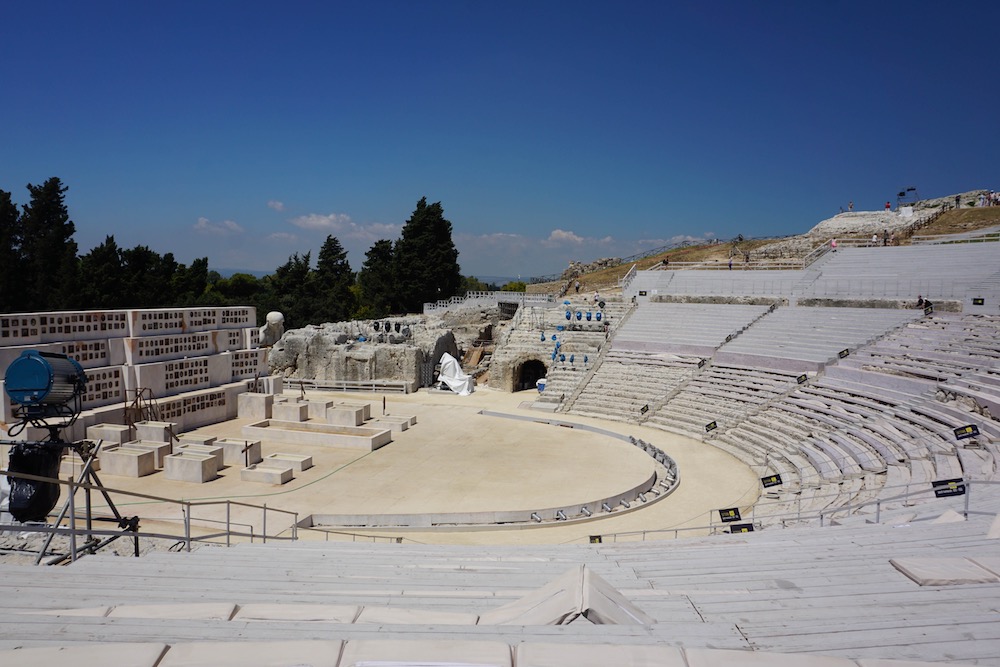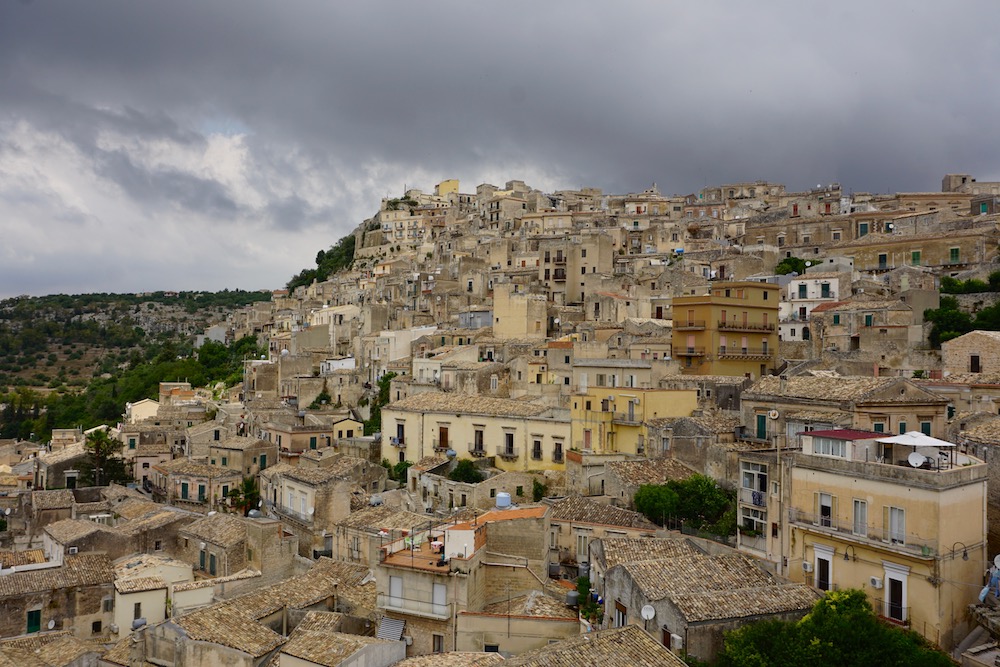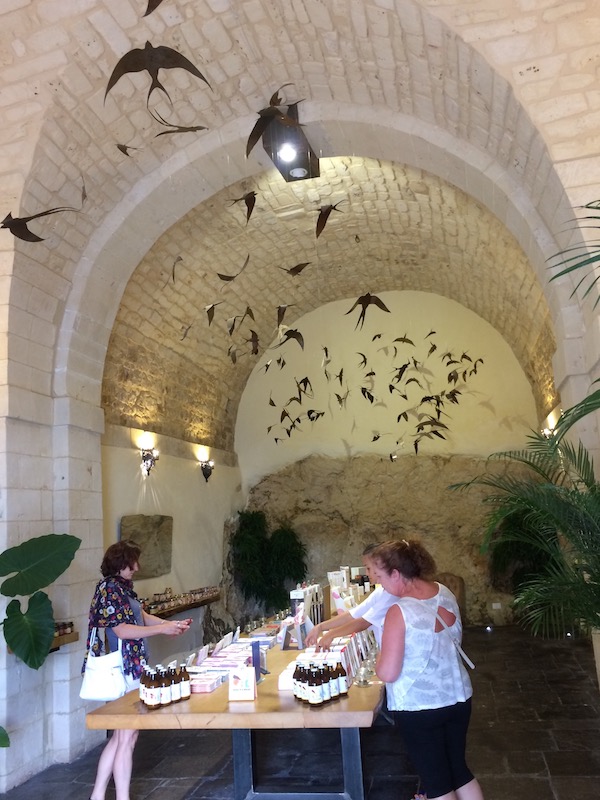“Feeling like getting Italian?” my husband asked, “Let’s hop on a plane from Eindhoven and in a couple of hours we’ll be in Catania, Sicily.” It was that easy!
Our destination for a long weekend was Siracusa, a wonderful city full of ancient history, wrapped up in warm glowing Baroque buildings, on the eastern coastline of Sicily. The city was originally founded on the tiny island of Ortigia by Greek settlers in 734 BCE but is a hotchpotch of Greek, Roman and Arabic rule, and the historic areas of the city reflect that.
Ortigia is the tourists “go to” and two bridges now connect the short distance, from mainland to island. Cars are discouraged and, honestly, it is easier and safer to wander by foot.

ORTIGIA (All photos by Jackie Harding)
Ortigia
Within the centre of this small island is a surfeit of Baroque and ancient buildings, which are connected by narrow mysterious alleyways, a system of ancient capillaries carrying life into the island. The yellow-hued buildings that crowd around the edge of the island huddle together overlooking the azure sea that brings the yachts of the rich and possibly famous into port.
This is the place for “sunset watching” and the aptly named Sun Set bar on Lungomare Alfeo, offered a perfect spot.
The interwoven streets provide a myriad of photo ops, little cafes and restaurants offer seats from which you can observe the tourists and locals alike, and tiny shops suggest you take some time to browse. Archimedes was born here and wandered these tiny streets, maybe pondering the mathematics challenges he became famous for.
The island has an ancient cathedral or duomo built around the bones of an original Greek temple, the original Doric columns now part of the walls of the building. Beneath the cathedral, you can explore the underground tunnels where locals hid during the bombing by both Allies and Nazis during WWII. The fortress at the tip of the island is also open to visit.

LOCAL OFFERINGS AT THE ORTIGIA MARKET
You can take a stroll along the seawalls, and wander through the daily (other than Sunday) food market close to the ruins of a Greek temple. The market is a delight, as are all local food markets when travelling. Here you can see fish lovingly displayed while the local cats prowl with longing around the stalls. The fruit and vegetable stalls are a rainbow display of produce, and tucked in a corner is a café where locals and tourists alike revel in espressos, wine and fresh cheeses.

SIRACUSA’S GREEK THEATER IS USED FOR EVENTS AND PERFORMANCES
Siracusa
Although Ortigia is the jewel in Siracusa’s crown, Siracusa has its own delights. Its major attraction is the Archeological Park of Neapolis, an area that contains one of the largest and finest remaining Greek theatres. It’s still used during the early summer months, so there’s a chance you will find it with modern day lighting rigs and seating.
Limestone cliffs, which have been quarried, border the park, and the remaining quarries have become verdant parks to wander on a hot day. (There is another quarry on the west side of the city that has been made into a lush garden, filled with nature’s creative carvings by the local Capuchin monks.)
PHOTO GALLERY -Our destination for a long weekend was Siracusa, a wonderful city full of ancient history, wrapped up in warm glowing Baroque buildings, on the eastern coastline of Sicily.
In the area nearest the theatre you can find Dionysus’s Ear, a manmade cave that was used to store water and occasionally prisoners. Its acoustics are great, and we were treated to a burst of song from a tour group whilst there! As well as the Greek theatre to visit in the park, there is also the Roman amphitheatre.
If it’s modern history that interests you, Siracusa also has a Commonwealth War cemetery that has over 1,000 graves of the Commonwealth forces killed in the battle that would begin the assault on Italy in 1943. There is another Commonwealth cemetery at Catania that has over 2,000 graves. It’s hard to imagine the horror these men experienced in the battle as you stand in these peace-filled places.

CALAMOSCHE
If beaches are a must, then Siracusa has a couple of areas to swim from but the better beaches are farther on down the coast … Fanusa, Arenella, Fontane Bianche, and Ognina. The beautiful nature reserve of Vendicari is worth a visit if you have a car. It is a bird-watchers delight during migration, with pristine beaches from where you can relax and swim in the crystal clear water.
We were told by a local of Calamosche about a small beach reached by a 1 kilometre-long walk through the unspoiled rocky headland. The air was filled with the humming of happy bees as they flew from one wild thyme bush to the next and, as you begin to wonder if you have taken a wrong turn, there ahead of you lay the small beach of Calamosche. It was worth the walk!

MODICA
NOTO, MODICA AND RAGUSA
If you have a car, then the surrounding area of Siracusa is worth exploring. The three cities of Noto, Modica and Ragusa are Baroque masterpieces, rebuilt in the 17th and 18th centuries after a devastating earthquake in 1693 reduced the original towns to rubble. They are a joy to explore, each with their own delights to offer, and all within a day’s drive from Siracusa.

SABADÍ
Noto, the UNESCO jewel in this Baroque threesome is worth visiting in the late afternoon as the sun hits the yellow stone of the city’s buildings turning them to gold. Sicilian Baroque architecture is full of elaborate embellishments and crazy-looking characters carved on the buildings, and there is no shortage of these in Noto.
The main street, Corso Vittorio Emmanuel, is full of inviting bars, restaurants and gelaterias and meets the piazza in front of the vast cathedral, where locals and tourists alike relax and chat under the gaze of the much-loved Cathedral San Nicolo di Mira.
The dome of this church has been rebuilt three times due to earthquake damage and only reopened after the last collapse in 2007. Just wander the streets in Noto and its mellow, relaxed pace will seep into your bones. Before long you’ll be thinking that maybe relocation there would be a great idea!
Modica is another rebuilt UNESCO Baroque treasure famous for its chocolate and its “stacked” city with steep sets of steps and cobbled streets. The main street, Corso Umberto, leads you past one of the many Baroque churches and offers other places to worship….the chocolate shops!
Sicilian chocolate is very similar to Mexican chocolate (cold processed with no cocoa butter added), coarse and a little bitter but nevertheless chocolate. Each little store offers tastings of their own personal products, each chocolatier creating interesting blends and flavors. No wonder everyone looks so chipper in Modica… those chocolate mood-enhancing chemicals seem to be in the air!
My belief is the city architects designed the town with steep staircases deliberately to counteract the chocolate consumption … a few hours wandering around this vertically challenged city and you are ready for the next chocolate tasting. One of the many places we sampled and bought chocolate was the award-winning organic chocolatier Sabadí, near the magnificent Duomo di San Gorgio.
Ragusa, another UNESCO delight, is in two parts. The newer part, Ragusa Superiore, was built after the devastating earthquake, but the local aristocrats didn’t want to leave their homes, so the original city was rebuilt and is known as Ragusa Ibla.
This old town clings to the sides of a steep gorge and provides winding cobbled streets to explore, views of the Sicilian countryside and, of course, stunning Baroque buildings. The piazza in front of the intricate cathedral offers the chance to sip a coffee or try a wine-flavored gelato from Galati DiVini. I tried one; it was lovely as was the olive oil gelato.
Ragusa is one of the many locations for the Italian detective series Montalbano, as is Modica and the little town of Scicli.
Scicli is a little more “off the beaten track” but worth a quick visit for its Baroque masterpiece, Palazzo Beneventano, its façade a creative collection of ghoulish faces and monsters. The Via Penna is a lovely pedestrian street with cafés, bars and more Baroque palaces and churches. Scicli’s poorer inhabitants once lived in cave dwellings above the town, the last leaving in 1958. The caves are not yet open to tourists and are overgrown, as is the abandoned cave church.
Siracusa and its surrounding area was a delight and such an easy destination for a long weekend. We immersed ourselves in Baroque architecture and the crystal clear sea, and devoured delicious local pasta dishes, wine and chocolate. The charm of the locals and their enthusiasm to share their love of Sicily was engaging and has left us with the wish to return…especially when my trove of Modica chocolate has disappeared.
How to get there
Ryanair fly from Eindhoven Airport to Catania three times a week
From Catania airport, it’s an easy taxi ride to Catania station followed by a 90-minute train ride to Siracusa.
Photographer/writer Jackie Harding was born in the United Kingdom. As a long-time expat, she lived in Boston for 12 years and in the Netherlands for the past 10 years.
Trained as a nurse in the U.K., she worked for nine years in the United States as a special education teacher’s assistant. Since moving to the Netherlands, she has discovered writing and photography.
Contributing to Dispatches since 2016, Jackie has written about her travels around Europe as well as about expat life and issues.
She also covered the Women’s March Amsterdam.
She’s married to British businessman Martin Harding and is the mother of two international adult children.















